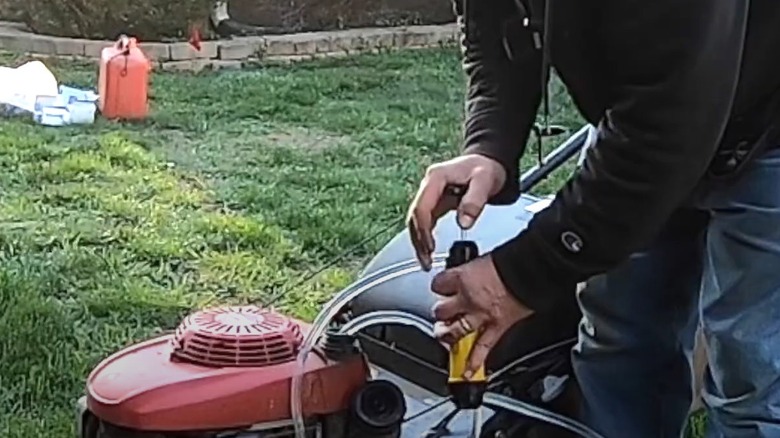Ideally, you took all the necessary steps to prepare your lawn mower for winter before putting it in storage. Then, when the grass is ready to cut in the spring, your lawn mower is ready to go. Unfortunately, it’s easy to forget about doing the winter preparation. You’ll probably wish you hadn’t forgotten when the lawn mower sputters and refuses to start the following spring. Although this issue could have several causes, one of the most common causes is having stale gas inside the tank on the machine.
Before adding new gas to the tank in the spring, be sure to look inside and see whether you left old gasoline in place all winter. If so, you’ll want to remove the old gasoline before you add fresh fuel and try to start the machine. In fact, if the gas sits in the tank on the lawn mower for even 30 days, it can become stale and unusable.
You can often look at and smell the gasoline to see if it is viable. “When inspecting fuel that has sat unused over the winter, watch for signs that it is darker in color and smells sour. It might have small pieces of gum floating in it,” Paul Herskind, a refined fuels expert at CHS, told The Lawn & Sprinkler Guys.
What can I do if I have old gas in my lawn mower?

HouseBarons/YouTube
Say you left the old gasoline in your mower from last fall. What should you do? You’ll need to figure out how to drain the fuel from the tank safely. Take all precautions to avoid spilling the gasoline on the ground as you remove it, as the fuel will soak into the ground and can cause contamination to groundwater while affecting insects and worms. Even though it appears to evaporate quickly, it can leave behind toxic chemicals after a spill.
If you have a siphon available, this is an option to move the fuel from the tank in the lawn mower to a safe storage container. If you are confident enough in your mechanic skills, remove the fuel line from the carburetor and drain the gas out of the tank into a safe container. Have the container ready as you disconnect the line, as the fuel will drain quickly. Or, if you can lift the mower, you can flip it over to pour the fuel into the container. Use a large funnel to catch all the gas.
When storing gasoline, you should use only containers that have the safety approval of Underwriters Laboratories (UL) or Factory Mutual (FM). You should then find a local recycling center that will accept the stale gasoline and will dispose of it properly. Never put it in your household trash.
What can happen if I use stale gas with my lawn mower?

Even though many lawn mowers will not start if they have old fuel in them from the previous season, some machines may start but will run very roughly, generate smoke, and struggle to keep running. If this happens, drain the tank safely and replace it with fresh gasoline as soon as you can to avoid long-term damage to the lawn mower. Your lawn mower should last several years with good maintenance, but you could shorten the lifespan quite a bit by running stale fuel through the machine, as it may leave clogs in the gas line and the fuel filter.
When you are pouring new gasoline into the lawn mower tank after draining it, be sure that the fuel you’re adding is not stale, too. You typically can store gasoline at your home for 6 to 12 months as long as you follow guidelines, like keeping the container tightly sealed and storing it away from sources of heat.
To avoid the problem with stale gas in the first place, you have a couple of options. If you have a little bit of fuel in the tank after your last yard cutting, you can allow the lawn mower to run until the tank is empty. You also can use a fuel additive in the autumn that will keep the gas viable until the following spring.



